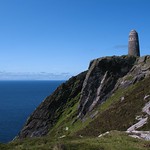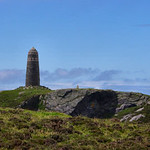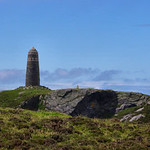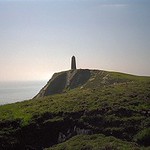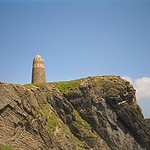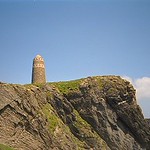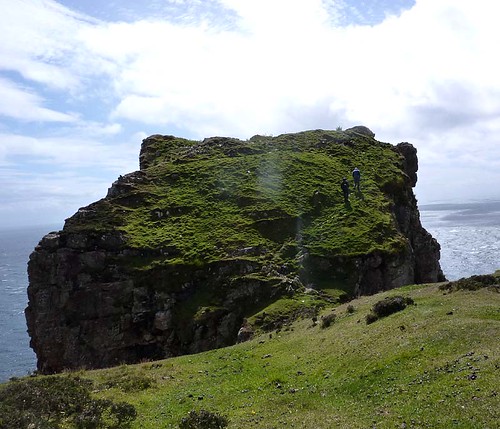American Monument - Mull of Oa
Cliff top monument on Mull of Oa in SW Islay commemorating loss of life from 2 ship sinkings in 1918. Walkable
American Monument: The American Memorial or “Monument” on the Mull of Oa, which is in the shape of a lighthouse, can be seen clearly from most of the Loch Indaal area and was created by the American Red Cross to commemorate the loss of two troop ships with great loss of life in 1918. The Tuscania, a passenger liner, was on its way from New Jersey to the coast of France with 2,000 American soldiers and a crew of more than 300. At Halifax, Nova Scotia, they joined a convoy and entered the British waters between Islay and Northern Ireland on the 5th of February. The convoy was followed by a UB-77 German submarine which torpedoed the Tuscania. The direct hit on the Tuscania resulted in heavy damage and the Tuscania sunk after a few hours, 7 miles off the Islay coast near the Oa peninsula. An estimated 230 lives were lost in this tragedy. A few months later on October 6 1918, another tragedy occured only a few miles from the place where the Tuscania sunk. The HMS Otranto was carrying troops from New York to Glasgow when it collided with the steamship HMS Kashmir during a heavy storm.
Lord George Robertson recalls:
Nobody who has ever visited the beautiful island of Islay needs to be told about the power of the sea. I was born in the police station in Port Ellen, and am well aware of the shipwrecks and disasters that shaped this place. My own grandfather, an island policeman, played a leading role in the aftermath of two dreadful sinkings during the first world war. Both took the lives of many American sailors, and my grandfather’s correspondence with their grieving families sat unread for years in an uncle’s attic. The stories remain very moving, almost ninety years later. Returning to the island to make a radio documentary about these events was an emotional experience.

The Tuscania was an Anchor Liner of 14.348 tons built by Stephens at Linthouse
On the February 5, 1918, the American troop ship the Tuscania, en route to Britain with more than 2,000 American soldiers on board, was torpedoed by a German submarine in the North Channel and sank seven miles off the Mull of Oa. More than 200 men either drowned in the seas off Islay or were dashed to death on the rocks. And on October 6 the same year, just a month before the armistice that would end the war, the American troop carrier Otranto collided with another ship and sank in Machir Bay on the west coast of the island. More than 400 lives were lost.
 These twin disasters rocked the island to its roots. Every family was touched, and many helped recover the dead and aid the survivors. The war had already reached Islay, of course. In common with every community in Scotland, Islay men had volunteered or been drafted into the armed forces. More than 100 men from the tiny community of Port Ellen had been killed in fighting on the mainland of Europe. Those that were left behind to till the soil or fish were old men or boys. On the stormy night of February 5 it fell to them to rescue the Tuscania’s survivors. When news of the sinking of the Tuscania reached America it had a shocking effect. It was the first time since the civil war that the Americans had incurred such a high number of casualties on a single day and the story received saturation coverage across the newspapers.
These twin disasters rocked the island to its roots. Every family was touched, and many helped recover the dead and aid the survivors. The war had already reached Islay, of course. In common with every community in Scotland, Islay men had volunteered or been drafted into the armed forces. More than 100 men from the tiny community of Port Ellen had been killed in fighting on the mainland of Europe. Those that were left behind to till the soil or fish were old men or boys. On the stormy night of February 5 it fell to them to rescue the Tuscania’s survivors. When news of the sinking of the Tuscania reached America it had a shocking effect. It was the first time since the civil war that the Americans had incurred such a high number of casualties on a single day and the story received saturation coverage across the newspapers.
Eight months later, the sinking of the Otranto horrified the American nation once more. When the Otranto went down in atrocious weather on Islay’s west coast in Machir Bay, one local American newspaper carried an account by the survivor Dave Roberts, describing how he was saved from the water: 'The waves carried me away from the ship, then one about as high as a house came over me and whirled me around like paper in a whirlwind. I went under. A Scotch lad got hold of a sailor and me and took us to a cottage. All I had left on was my underwear, pants and shirt - one sock. When we got to the shore, they put us to bed. It sure was fine, two pair of woollen blankets. The people there could not have treated us any better.'

The Otranto
My maternal grandfather, Malcolm MacNeill, was the police sergeant in Bowmore. Long before the invention of patrol cars he used a bicycle to get around the island. After the two disasters it was his responsibility to report what had happened, and to undertake the distressing job of logging the bodies, noting any distinguishing marks that could help identify the drowned men.  His notebooks, which I have donated to the Museum of Islay Life, make powerful reading. In them, in meticulous copperplate, he records descriptions of the bodies washed ashore, savagely battered by the rocks. Many were identifiable only by their tattoos or the military tags they wore. One entry reads '25-year-old male. Tattoo of 'Mum' on right arm. No other identifying marks.' There were so many dead bodies that their descriptions filled 81 pages in his notebook. When the bodies were finally buried, it fell to my grandfather to correspond with the families in the United States, who were desperate for news of their loved ones. They wrote from Georgia, from the Midwest and from the northeastern states, providing information about birthmarks or prized watches, which they hoped could be used to identify the bodies of their sons, husbands or brothers. My grandfather, in an extraordinary example of compassionate public service, replied to each letter, providing what information he could. Often, sadly, there was little information that he could pass on. His work was applauded by the American Red Cross and at the end of the war he was awarded the MBE for his actions on those terrible nights.
His notebooks, which I have donated to the Museum of Islay Life, make powerful reading. In them, in meticulous copperplate, he records descriptions of the bodies washed ashore, savagely battered by the rocks. Many were identifiable only by their tattoos or the military tags they wore. One entry reads '25-year-old male. Tattoo of 'Mum' on right arm. No other identifying marks.' There were so many dead bodies that their descriptions filled 81 pages in his notebook. When the bodies were finally buried, it fell to my grandfather to correspond with the families in the United States, who were desperate for news of their loved ones. They wrote from Georgia, from the Midwest and from the northeastern states, providing information about birthmarks or prized watches, which they hoped could be used to identify the bodies of their sons, husbands or brothers. My grandfather, in an extraordinary example of compassionate public service, replied to each letter, providing what information he could. Often, sadly, there was little information that he could pass on. His work was applauded by the American Red Cross and at the end of the war he was awarded the MBE for his actions on those terrible nights.
His letters to his superiors also provide a powerful account of how the people of Islay rushed to the aid of the young men who were washed up on their shore. 'Sir, The following people took an active part in the rescue of survivors from the water, and afterwards materially assisted them in recovering from the effects of their long and terrible exposure. The first persons on the scene so far as I am able to ascertain were David McTaggart, farmer Kilearan, who had previously to this dispatched horse and van for life saving apparatus and Donald McLachan, ploughman. These two men brought three survivors out of the water with the aid of a long broom handle. One girl, Kate McLellan, Coulerach, in my opinion deserves special mention. She happened to be on the rocks when the McPhee boys rescued the first three survivors, one of whom was scantily clad. The girl at once in the midst of hail and sleet stripped off her own overcoat and wrapped it round the rescued soldier.' Later he commends the old women who supplied soup and somehow managed to lay their hands on food to nurse the survivors back to health. In the report which he filed on the wreck, my grandfather went out of his way to commend the ordinary folk who, though they had so little, gave so much to help those who were wrecked on their shores.
 After he died I discovered the letters and donated my grandfather’s notebooks, and his correspondence with the families of those who had died at sea, to the Museum of Islay Life in Port Charlotte, which holds mementoes of the Tuscania disaster, including the salvaged ship’s bell. But as well as my grandfather’s log book, there are living memories of the disasters on Islay, too. The Port Ellen fisherman Jim MacFarlane told me that he remembers being told about groups of women standing in the street in Port Ellen, weeping while the bodies of the young men were taken through the town to a temporary mortuary, now the town’s cyber cafe. Duncan McPhee, who lives with his mother at the coastguard residence at Kilchoman is the grandson of one of the two teenaged McPhee brothers who waded into the surf in Machir Bay in 1918 to rescue survivors of the Otranto, using a walking stick to reach out to the men in the water. Thanks to their bravery three men lived who would otherwise have drowned. I stood in the McPhee’s living room and read the mementoes commemorating that night. These had been passed down through the family. There were newspaper clippings, and a faded photograph album which had been produced by a local photographer at the time. Looking through its sepia images of funerals, and bodies being carried through the streets of Port Ellen it was hard to believe that the accidents had occurred almost ninety years ago. And there also is physical evidence of the two wrecks on Islay. Over the years divers have been down to the two wrecks and brought up shell casings, bullets and other dark mementoes of 1918. The cemetery at Kilchoman was once filled with the graves of the American sailors who died when the Otranto went down. But in 1920 the American government ordered that the bodies of the fallen men be exhumed and taken either back to the US or to the American military cemetery at Brookwood, Surrey. That same year, the American Red Cross erected the monument at the Mull of Oa to the American seamen who had died in the Tuscania.
After he died I discovered the letters and donated my grandfather’s notebooks, and his correspondence with the families of those who had died at sea, to the Museum of Islay Life in Port Charlotte, which holds mementoes of the Tuscania disaster, including the salvaged ship’s bell. But as well as my grandfather’s log book, there are living memories of the disasters on Islay, too. The Port Ellen fisherman Jim MacFarlane told me that he remembers being told about groups of women standing in the street in Port Ellen, weeping while the bodies of the young men were taken through the town to a temporary mortuary, now the town’s cyber cafe. Duncan McPhee, who lives with his mother at the coastguard residence at Kilchoman is the grandson of one of the two teenaged McPhee brothers who waded into the surf in Machir Bay in 1918 to rescue survivors of the Otranto, using a walking stick to reach out to the men in the water. Thanks to their bravery three men lived who would otherwise have drowned. I stood in the McPhee’s living room and read the mementoes commemorating that night. These had been passed down through the family. There were newspaper clippings, and a faded photograph album which had been produced by a local photographer at the time. Looking through its sepia images of funerals, and bodies being carried through the streets of Port Ellen it was hard to believe that the accidents had occurred almost ninety years ago. And there also is physical evidence of the two wrecks on Islay. Over the years divers have been down to the two wrecks and brought up shell casings, bullets and other dark mementoes of 1918. The cemetery at Kilchoman was once filled with the graves of the American sailors who died when the Otranto went down. But in 1920 the American government ordered that the bodies of the fallen men be exhumed and taken either back to the US or to the American military cemetery at Brookwood, Surrey. That same year, the American Red Cross erected the monument at the Mull of Oa to the American seamen who had died in the Tuscania.

The Tuscania and the Otranto are not of course the only connections between Islay and the United States. One Islay resident, Alexander McDougall, born in Portnatruin in 1732, headed the 1st New York Regiment during the American Civil War. My own career took me from the Port Ellen police station where I was born in 1946 to the heart of the North Atlantic Treaty Organisation. When I served as secretary general of Nato, I told Colin Powell, then the US Secretary of State, about the body of an unnamed black sailor still buried in the soil of Islay. Wars draw human beings from one side of the globe to another, and can bring the most unexpected occurrences, and inspire acts of genuine heroism. I know from my experience as Britain’s secretary of state for defence, and from my time at Nato, just how long it takes for the memories of wars to fade. But I also know the incredible resourcefulness it can demand from ordinary people. Having revisited for the BBC this extraordinary story of the Islay folk who sprang into action to help those in need almost 90 years ago, I am convinced that their efforts should be remembered as one of the finest episodes in the island’s long history.


